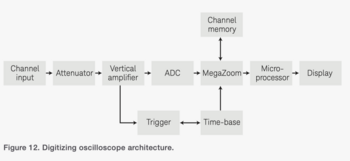Basic Types of Oscilloscopes
Back to overview of articles from the Oscilloscopes Basics series
There is a wide range of oscilloscopes available. By getting an overview of the basic types of oscilloscopes on the market and comparing their performance to your project’s requirements, you will be able to choose just the right one and decide between a new, OEM-refurbished or used instrument, too.
The common factor: Signal integrity
An oscilloscope’s purpose is to provide an image of an electrical signal which conveys information about its nature, including possible errors within the circuit. To be usable, this representation has to be as accurate as possible. This is expressed through the term signal integrity. An oscilloscope that only has low signal integrity will distort the waveform to the point that the data becomes unreliable and impossible to base conclusions on. High signal integrity means the oscilloscope is able to reconstruct the representation of the actual signal accurately.
Of course, even the best oscilloscope in the world will be unable to provide a perfect image of the actual signal. The connection between a scope and a circuit needed for performing measurements lets the instrument become one element within the circuit, inevitably causing loading effects. Good oscilloscopes will keep these effects as small as possible.
Analog oscilloscopes
Analog oscilloscopes were the first to be developed. They used cathode-ray tubes and phosphor screens to display a waveform. As an electron would hit the phosphor, the photoluminescent material lit up, visibly tracing the signal. Concurrent traces would overlap, uncovering irregularities and specifically glitches in the respective signal. At the same time, increasing intensity of illumination in stable portions of the waveform added a third dimension to the two axes of time and voltage, corresponding to the signal’s intensity.
The fundamental issue analog scope unfortunately have is their inability to save data in any form beyond the illumination period of the phosphor. Additionally, all measurements and calculations have to be performed by hand. The physical limits of the cathode-ray tube also limit what kind of signals can be displayed as the speed of an electron beam’s sweeping cannot be accelerated indefinitely. As a result of these problems, and their successful resolution by digital oscilloscopes, analog scopes have been largely replaced and are not readily available for sale.
DSOs
The waveform is first attenuated to a bandwidth the oscilloscope can process, mainly through the attenuator, with a vertical amplifier performing further scaling. The waveform is then passed to the ADC, which samples the signal as well as digitizes the information. This data can be conveniently stored in the built-in memory. A trigger locates the defined trigger event and sets the observed time window. Additional processing can be programmed and performed by the microprocessor. Finally, the waveform is rendered on the display that is either part of the oscilloscope or on a connected device like a PC or external monitor.
The digital form allows for practically unlimited measurements and calculations based on the data gathered, as well as indefinite storage. Using varying connectivity features, information can be transferred to other devices.
MSOs
Advanced projects might generate both analog and digital signals that need to be analyzed. Mixed signal scopes, also known as MSOs, fill this need by monitoring both types of signals at the same time. Typically, these scopes provide 2 to 4 analog and even more digital channels, usually 8 or as many as 16. MSOs can locate trigger events through a composite of analog and digital signals without issue, as well as display all of them on a correlated time base.
Portable or handheld oscilloscopes
As indicated by its name, a handheld oscilloscope is one that so light and compact it can be carried around. It is perfectly suited to moving from location to location, either in field work or between work stations in a lab. These scopes are portable, lightweight, start up quickly, and are user friendly. Their performance power is a bit more limited compared to a benchtop oscilloscope, but easily satisfy the most common debugging requirements.
High-performance oscilloscopes
Quite large in size and at the upper end of the price range, high-performance oscilloscopes offer the very best specifications available. High speed, high bandwidth and high stakes projects likely need one of these. If you are working on smaller projects though, odds are a simpler or used oscilloscope will make the needed measurements just as accurately.
Economy oscilloscopes
Economy oscilloscopes are designed with lower price points in mind, which means they have more limited performance capabilities. These oscilloscopes are often used in the education sector, for example university laboratories, due to budget restraints.
If you are looking for better performance while working within the restraints of a tighter budget, you might be well served with a used or refurbished oscilloscope. Since oscilloscopes are typically durable and sturdy instruments, they can perform reliably and accurately even after years of usage. Although they might not offer all the options newer models do, a good-quality used oscilloscope may well provide better performance than a new economy one.
These are just some of the many types of oscilloscopes available. As discussed above, they can be differentiated by their functionality (digital vs. analog), form (stationary vs. handheld), performance (bandwidth, speed etc.), connectivity (USB or external monitor ports among others), and price point (e.g. economy or used oscilloscopes).
To decide which oscilloscope is best for your needs, closely study the model’s performance sheet or contact us for a recommendation: Find more information on the Keysight Used Equipment Platform.







































































